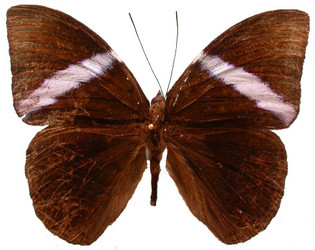Pseudergolinae
Niklas Wahlberg and Andrew V. Z. Brower


This tree diagram shows the relationships between several groups of organisms.
The root of the current tree connects the organisms featured in this tree to their containing group and the rest of the Tree of Life. The basal branching point in the tree represents the ancestor of the other groups in the tree. This ancestor diversified over time into several descendent subgroups, which are represented as internal nodes and terminal taxa to the right.

You can click on the root to travel down the Tree of Life all the way to the root of all Life, and you can click on the names of descendent subgroups to travel up the Tree of Life all the way to individual species.
For more information on ToL tree formatting, please see Interpreting the Tree or Classification. To learn more about phylogenetic trees, please visit our Phylogenetic Biology pages.
close boxIntroduction
Pseudergolinae is a small clade of seven species occurring in Southeast Asia and the Malay Archipelago, and one more species in New Guinea.
Phylogenetic Position of Pseudergolinae
The relationships of Pseudergolinae have been enigmatic for a long time. Traditionally, they have been placed in the Limenitidinae, with one species (Amnosia decora) even being transfered to the tribe Nymphalini, and the genus Dichorragia being placed in Apaturinae. Molecular data have given a much clearer picture, supporting the hypothesis that Pseudergolinae is a monophyletic group (Wahlberg et al. 2003, 2005, 2009). Pseudergolinae is sister group to the remainder of the nymphaline clade (Wahlberg et al. 2009).
Discussion of Phylogenetic Relationships
The topology illustrated is that of Wahlberg et al. (2005), who sampled only one species per genus. However, species within genera are very similar to one another, and the genera differ significantly from each other morphologically. Thus the sister relationships of species within genera appear to be quite certain.
References
Wahlberg, N., A. V. Z. Brower, and S. Nylin. 2005. Phylogenetic relationships and historical biogeography of tribes and genera in the subfamily Nymphalinae (Lepidoptera: Nymphalidae). Biological Journal of the Linnean Society 86:227-251.
Wahlberg, N., J. Leneveu, , U. Kodandaramaiah, U., C. Peña, , S. Nylin, A. V. L. Freitas & A. V. Z. Brower. 2009. Nymphalid butterflies diversify following near demise at the cretaceous/tertiary boundary. Proc. R. Soc. London B 276, 4295-4302.
Wahlberg, N., E. Weingartner, and S. Nylin. 2003. Towards a better understanding of the higher systematics of Nymphalidae (Lepidoptera: Papilionoidea). Molecular Phylogenetics and Evolution 28:473-484.
Title Illustrations

| Scientific Name | Amnosia decora |
|---|---|
| Specimen Condition | Dead Specimen |
| Identified By | Niklas Wahlberg |
| Life Cycle Stage | Adult |
| Body Part | Whole |
| View | upperside |
| Image Use |
 This media file is licensed under the Creative Commons Attribution-NonCommercial License - Version 3.0. This media file is licensed under the Creative Commons Attribution-NonCommercial License - Version 3.0.
|
| Copyright |
© Niklas Wahlberg

|
About This Page
Niklas Wahlberg

University of Turku, Finland
Andrew V. Z. Brower

Middle Tennessee State University, Murfreesboro, Tennessee, USA
Correspondence regarding this page should be directed to Niklas Wahlberg at
niklas.wahlberg@utu.fi
and Andrew V. Z. Brower at
abrower@mtsu.edu
Page copyright © 2009 Niklas Wahlberg and Andrew V. Z. Brower
 Page: Tree of Life
Pseudergolinae .
Authored by
Niklas Wahlberg and Andrew V. Z. Brower.
The TEXT of this page is licensed under the
Creative Commons Attribution License - Version 3.0. Note that images and other media
featured on this page are each governed by their own license, and they may or may not be available
for reuse. Click on an image or a media link to access the media data window, which provides the
relevant licensing information. For the general terms and conditions of ToL material reuse and
redistribution, please see the Tree of Life Copyright
Policies.
Page: Tree of Life
Pseudergolinae .
Authored by
Niklas Wahlberg and Andrew V. Z. Brower.
The TEXT of this page is licensed under the
Creative Commons Attribution License - Version 3.0. Note that images and other media
featured on this page are each governed by their own license, and they may or may not be available
for reuse. Click on an image or a media link to access the media data window, which provides the
relevant licensing information. For the general terms and conditions of ToL material reuse and
redistribution, please see the Tree of Life Copyright
Policies.
- First online 25 September 2006
- Content changed 18 November 2009
Citing this page:
Wahlberg, Niklas and Andrew V. Z. Brower. 2009. Pseudergolinae . Version 18 November 2009 (under construction). http://tolweb.org/Pseudergolinae/69948/2009.11.18 in The Tree of Life Web Project, http://tolweb.org/







 Go to quick links
Go to quick search
Go to navigation for this section of the ToL site
Go to detailed links for the ToL site
Go to quick links
Go to quick search
Go to navigation for this section of the ToL site
Go to detailed links for the ToL site